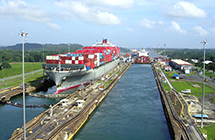 |
 |
|
| eNews • July 2017 | ||
| Promoting a Cost-Effective, Reliable and Competitive Transportation System |
||
 Expanded Panama Canal reaches first anniversary
Expanded Panama Canal reaches first anniversary
June 26 marked the one year anniversary of the expansion of the Panama Canal, and the Central American waterway's performance since the expansion has exceeded what was originally forecast, according to canal authorities.
Of note, tonnage through the canal has increased by 22.2 percent from the same period in 2015-2016, due in large part to the 1,500 Neopanamax vessels that have since transited the canal since the expansion.
According to canal figures, containerships represent around 51.3 percent of vessel traffic through the canal, followed by liquefied petroleum gas (LPG) and liquefied natural gas (LNG) carriers, which represent approximately 31.5 and 9.1 percent, respectively. The remaining segments include bulk carriers, tankers, car carriers and passenger vessels.
Other achievements in the first year of operation for the larger third lane of the canal include:
- A total of 15 out of 29 liner services that use the Panama Canal now employ Neopanamax vessels, mostly sailing between Asia and the U.S. East Coast;
- An average of 5.9 vessels transit the expanded canal per day, up from original first-year forecasts of two to three daily transits;
- More than 90 percent of the global LNG fleet can now transit the waterway for the first time in history, opening a new market and allowing LNG producers in the United States to ship natural gas to Asia at competitive prices, according to canal authorities;
- And LPG traffic has become second biggest driver of Neopanamax traffic at roughly 31.5 percent of transiting vessels.
Looking ahead, the Panama Canal has various transshipment infrastructure projects planned, including a roll-on/roll-off (ro-ro) terminal being redeveloped into a redistribution center for vehicle machinery and heavy equipment, a 1,200-hectare logistics park to further strengthen logistics services in the region, and an LNG terminal on the Atlantic side of the waterway to provide LNG bunkering and redistribution capabilities.
Furthermore, the ACP will continue to advance plans for the Corozal Container Terminal, said canal authorities.
“Today’s milestone provides us with an opportunity to reflect on the Canal’s strong performance to-date and the industry’s wide-spread adoption of the waterway,” said Panama Canal Administrator Jorge L. Quijano.
“Looking forward, the next decade will serve as a significant next chapter in the Panama Canal’s story as we continue to advance various infrastructure projects within the region to further position Panama as the logistics hub of the Americas—for the benefit of our customers, and for the people of Panama,” he continued.
Source: American Shipper
Soy Transportation Coalition |
|
